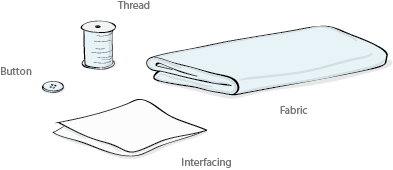Material parts
What are the parts of a shirt?
One way to answer this question is to list the types of materials that are used to construct a shirt. The four types of materials are thread, fabric, interfacing, and button.

Each of these is a class in the Shirt Ontology. There is the Thread class, the Fabric class, the Interfacing class, and the Button class. A shirt is made up of these four types of materials, and nothing else. The material parts are essentially the “ingredients” of a shirt.
This part relationship can be represented as:
Shirthas material partThread, Fabric, Interfacing, Button
(You may be wondering what interfacing is. It is a fabric-like material that is put inside the collar, cuffs, and front bands to provide stiffness.)
The idea of a class is fundamental to ontologies. A class is a formal way to represent similar types of things in the world. The class “button” represents things that are buttons. The class “interfacing” represents things that are interfacing. This is different than talking about a specific button or a specific piece of interfacing. Classes are a way to refer to a category of things, without refering to a specific individual thing.
On the previous page an ontology was defined as a set of terms and the relationships among the terms. A more precise definition of an ontology is that it is a set of classes and the relationships among the classes. In this tutorial, classes will be represented as terms within blue boxes.
In the FMA
The FMA does not have material parts, but has a similar modeling scheme, using “constitutional parts”. When an anatomical structure is divided into constitutional parts, it is divided into parts that are more simple in composition.
These are the constitutional parts of the class Brain:
Brainhas constitutional partNeural tissue of brain, Ventricular system of brain, Vasculature of brain
The class Ventricular system of brain has its own constitutional parts:
Ventricular system of brainhas constitutional partWall of ventricular system of brain, Cavity of brain
Notice that Cavity of brain is a space. In the FMA, constitutional parts include both parts with mass (“material parts”) and the spaces within those parts.
